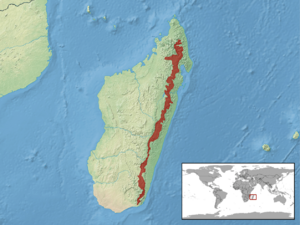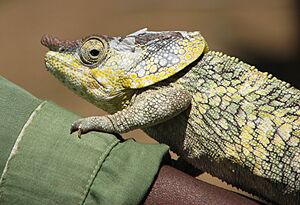Short-horned chameleon facts for kids
Quick facts for kids Short-horned chameleon |
|
|---|---|
 |
|
| female, Andasibe, Moramanga | |
| Conservation status | |
| Scientific classification | |
| Genus: |
Calumma
|
| Species: |
brevicorne
|
 |
|
The short-horned chameleon (also known as Calumma brevicorne) is a special type of chameleon. It lives only in Madagascar. This means it is endemic to that island.
Contents
About the Short-Horned Chameleon
This chameleon has a body that looks a bit flattened. It has thin legs and feet that can grip branches tightly. Its tail can also grab things, like a fifth limb! This helps it move easily through trees and bushes.
One cool thing about this chameleon is its large, ear-like flaps. These are called occipital lobes. Males also have a short, bony horn on their nose. When the chameleon feels scared, it raises these ear flaps. This makes it look bigger to scare away danger. It might also open its mouth wide to look more threatening.
Short-horned chameleons are usually gray. But their colors can change! Males are a bit bigger and often have lighter heads. Some chameleons might be greener or even have blue legs.
Where Do Short-Horned Chameleons Live?
The short-horned chameleon lives only in Madagascar. It can be found across a wide area in eastern Madagascar. This stretches from the Anosy Mountains in the south to the Tsaratanana Massif in the north. It also lives in a specific area in the northwest called the Analavory Plateau.
These chameleons prefer to live at certain heights. They are usually found between 810 and 1,000 meters above sea level. The IUCN lists this chameleon as a "Least Concern" species. This means its population is stable and not currently at risk. For example, in forests near Andasibe-Mantadia National Park, there are about 2 to 3 chameleons per hectare.
Life and Habitat of the Short-Horned Chameleon
These chameleons live in humid forests that are not too high up. They often like areas with more open plants. You can find them near the edges of forests or in places where the habitat has been changed a bit. They can even live in farm areas if there are still trees around. Sometimes, they are seen in trees near roads or buildings.
We don't know a lot about how these chameleons live in the wild. But when they are kept by people, they eat many different kinds of insects.
Reproduction and Eggs
Female short-horned chameleons lay eggs. They usually lay between 10 and 30 eggs. This happens about 40 days after they mate. Sadly, the eggs of Calumma brevicorne can be eaten by black rats. These rats are an invasive species, meaning they are not native to Madagascar and can harm local wildlife.



